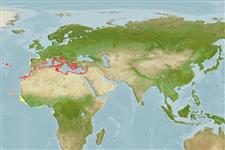>
Eupercaria/misc (Various families in series Eupercaria) >
Labridae (Wrasses) > Corinae
Etymology: Thalassoma: Greek, thalassa = the sea + Greek, soma = body; the colour of the sea (Ref. 45335).
More on author: Linnaeus.
Environment: milieu / climate zone / depth range / distribution range
पारिस्थितिकी
समुद्री प्रवाल-भित्ति संयुक्त; गहराई सीमा 1 - 150 m (Ref. 2683), usually 1 - 50 m (Ref. 4742). Subtropical; 18°C - 25°C (Ref. 130600); 46°N - 1°S, 32°W - 36°E
Eastern Atlantic: Portugal to south of Cape Lopez, Gabon and including the islands of Azores, Madeira, Canary, São Tomé and Annobon. Also in the Mediterranean.
आकार / वज़न / Age
Maturity: Lm ? range ? - ? cm
Max length : 25.0 cm SL पुल्लिंग / अलिंग; (Ref. 4742); common length : 20.0 cm SL पुल्लिंग / अलिंग; (Ref. 4742)
Inhabits coastal waters near rocks and eel-grass beds. Usually solitary, sometimes in small groups. Feeds on small mollusks and crustaceans (Ref. 4742). Protogynous hermaphrodite, with distinct sexual dichromatism (Ref. 5292). Eggs are pelagic (Ref. 4742).
Gomon, M.F. and P. Forsyth, 1990. Labridae. p. 868-882. In J.C. Quero, J.C. Hureau, C. Karrer, A. Post and L. Saldanha (eds.) Check-list of the fishes of the eastern tropical Atlantic (CLOFETA). JNICT, Lisbon, SEI, Paris; and UNESCO, Paris. Vol. 2. (Ref. 5292)
IUCN Red List Status (Ref. 130435)
Threat to humans
Harmless
Human uses
मात्स्यिकी: लघु वाणिज्य; आखेट मत्स्य: हां; जलजीवालय: व्यापारिक
अधिक जानकारी
Age/Sizeबाढ़Length-weightLength-lengthLength-frequenciesमौरफोमैटरिक्सआकृति विज्ञानलार्वालारवल गतिकीभर्तीबहुतायतBRUVS
संदर्भजलीयकृषिजलीयकृषि रूपरेखाखींचआनुवंशिकीElectrophoresesहैरेटिबिलटीबीमारीप्रक्रमणNutrientsMass conversion
सहयोगीयोतस्वीरेStamps, Coins Misc.ध्वनिसिगुयटिरारफ्तारतैरने के प्रकारगिल क्षेत्रOtolithsदिमागदृष्टि
साधन
Special reports
Download XML
इंटरनेट स्रोत
Estimates based on models
Preferred temperature (Ref.
123201): 14.9 - 21.6, mean 18.7 °C (based on 294 cells).
Phylogenetic diversity index (Ref.
82804): PD
50 = 0.5000 [Uniqueness, from 0.5 = low to 2.0 = high].
Bayesian length-weight: a=0.00955 (0.00430 - 0.02123), b=3.06 (2.89 - 3.23), in cm total length, based on LWR estimates for this Genus-body shape (Ref.
93245).
Trophic level (Ref.
69278): 3.5 ±0.47 se; based on food items.
लौटाव (Ref.
120179): माध्यम, न्यूनतम जनसंख्या दुगनी होने का समय 1.4 - 4.4 वर्ष। (Preliminary K or Fecundity.).
Fishing Vulnerability (Ref.
59153): Low vulnerability (21 of 100).
Climate Vulnerability (Ref.
125649): Low vulnerability (22 of 100).
Nutrients (Ref.
124155): Calcium = 34.5 [16.9, 74.6] mg/100g; Iron = 0.592 [0.326, 1.148] mg/100g; Protein = 19.1 [16.3, 21.3] %; Omega3 = 0.254 [0.146, 0.436] g/100g; Selenium = 16.2 [8.0, 31.0] μg/100g; VitaminA = 76.5 [23.0, 320.5] μg/100g; Zinc = 0.952 [0.615, 1.593] mg/100g (wet weight);
